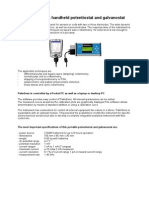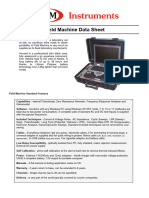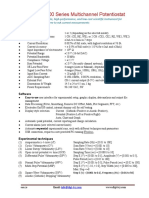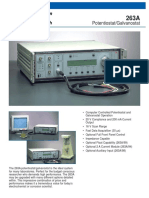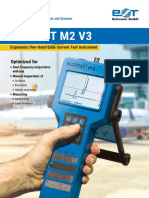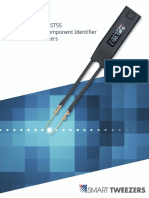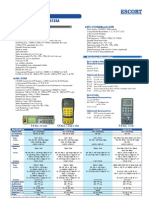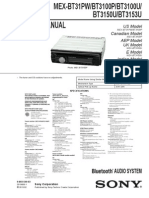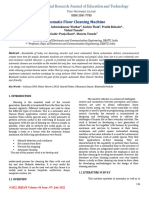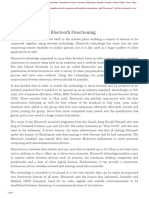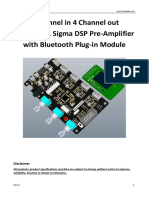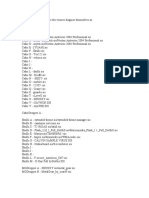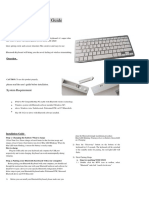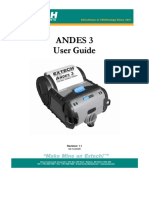potentiostat/galvanostat/impedance analyser
Rev. 5-2015
�Contents
Contents
PalmSens3: potentiostat/galvanostat/impedance analyser ..........................................................2
Supported techniques .................................................................................................................3
Measurement specifications ........................................................................................................4
System specifications ..................................................................................................................5
Frequency Response Analyser for EIS accuracy contour plot ......................................................6
Standard PalmSens3 configuration ..............................................................................................7
PalmSens3 accessories ...............................................................................................................8
Mobile expansion pack .........................................................................................................8
Magnetic stirrer.....................................................................................................................8
Pt1000 .................................................................................................................................8
MUX8 or MUX16 multiplexer.................................................................................................8
BiPot extension ....................................................................................................................9
Differential Electrometer Amplifier (DEA) ................................................................................9
�PalmSens3: potentiostat/galvanostat/impedance analyser
PalmSens3: potentiostat/galvanostat/impedance analyser
PalmSens3 is a battery-powered, handheld instrument which allows the application of the most
relevant voltammetric, amperometric and potentiometric techniques as well as impedance
spectroscopy. Each PalmSens3 is shipped in a rugged carrying case (see page 7).
PalmSens3 can be controlled by PC and tablets as well as phones using Android.
PSTrace for Windows provides support for all techniques and device functionalities.
Minimum PC requirements are: Windows XP (SP3), 2 GHz processor and 2 GB RAM.
PSTouch for Android supports all techniques supported by PalmSens3, except impedance
spectroscopy (EIS).
See also the Mobile Expansion Pack on page 8.
For more information about software visit www.palmsens.com/software
�Supported techniques
Supported techniques
Voltammetric techniques
Linear Sweep Voltammetry
Differential Pulse Voltammetry
Square Wave Voltammetry
Normal Pulse Voltammetry
ac Voltammetry
Cyclic Voltammetry
Stripping Chronopotentiometry (or PSA)
LSV
DPV
SWV
NPV
acV
CV
SCP
Note: these techniques can also be used for stripping voltammetry
Techniques as a function of time
Amperometric Detection
Pulsed Amperometric Detection
Multiple Pulse Amperometric Detection
Fast Amperometry
Potentiometry
Open Circuit Potentiometry
Multistep Amperometry
Multistep Potentiometry
AD (Chronoamperometry)
PAD
MPAD
FAMP
POT
OCP
MA
MP
Impedance spectroscopy / EIS
Frequency scan
Potential scan
Fixed potential
Time scan
A potential scan can be done at fixed frequency or making a frequency scan at each potential.
The current is measured using a zero resistance ammeter (ZRA).
Where possible, the electrochemical techniques can be applied using auto ranging which means
that the instrument automatically sets the optimal current range. The user can specify a highest
and lowest current range in which the most appropriate range is selected automatically.
See page 5 for system specifications.
�Measurement specifications
Measurement specifications
General pretreatment:
Apply conditioning, deposition or initial potential for: 0 1600 s
General voltammetric parameters:
Potential range:
-5.000 V to + 5.000 V
Step potential:
0.1 mV to 250 mV
Pulse potential:
1 mV to 250 mV
Limits of some technique specific parameters for PalmSens3:
NPV and DPV:
Scan rate:
Pulse time:
0.15 mV/s (0.15mV step) to
100 mV/s (5 mV step)
10 ms to 300 ms
SWV:
Frequency:
1 Hz to 2000 Hz 1
acV:
Frequency:
1 Hz to 2000 Hz
SCP:
Sampling rate:
Approx. 100 kHz, max. 100 s
LSV and CV:
Scan rate:
0.01 mV/s (0.15 mV step) to
500 V/s (5 mV step)
AD and PAD:
Interval time:
Pulse time:
Run time:
Maximum number of points:
1 ms (10 ms for PAD) to 300 s
1 ms to 1 s
10 s to 100000 s
65000
MPAD:
Pulse times:
Run time:
Number of potential levels:
Maximum number of points:
100 ms to 2 s
10 s to 100000 s
3
65000
Fast amperometry:
Interval time:
Maximum run time:
Maximum number of points:
0.01 ms to 1 s
30 s
20000, but 4000 for interval time < 0.2 ms
Potentiometry at
constant current or
at open circuit:
Interval time:
Maximum run time:
1 ms to 300 s
100000 s
Multistep
amperometry and
potentiometry
Interval time:
Number of potential levels:
Number of cycles:
Maximum run time:
100 ms to 30 s
1 to 255
1 to 20000
100000 s
Note: some limits of parameters are set for practical reasons and can be modified on request.
(1) PSTrace provides the option to measure forward and reverse currents separately.
�System specifications
System specifications
Controlled potential mode (potentiostat)
dc-potential range
compliance voltage
dc-potential resolution
applied potential accuracy
current ranges
maximum measured current
current resolution
accuracy
max. acquisition rate
5.000 V
8.0 V
0.15 mV
0.2 %
with max. 2 mV offset error
100 pA to 10 mA (9 ranges)
30 mA (typical)
0.01 % of current range
1 % of current range at 1 nA ( 5 % at 100 pA)
0.5 % at 10 nA
0.2 % at 100 nA to 1 mA
0.5 % at 10 mA
all with max. 0.2 % offset error
200 000 data points/s
Controlled current mode (galvanostat)
current ranges
dc-current range
dc-current resolution
max. dc-offset error
current accuracy (deviation)
maximum output voltage
1 A to 10 mA
3.000 times selected current range
0.01 % of selected current range
0.2 %
0.4 %
8V
Impedance measurements
frequency range
ac- amplitude range
100 Hz to 50 kHz
1 mV to 0.3 V (rms)
General
electrometer amplifier input
rise time
> 100 Gohm // 4 pF
programmable from min. 0.5 s
Other
keypad
housing
weight
temperature range
power supply
battery time
communication
auxiliary port
run, skip, abort, backlight and power
aluminium: 155 mm x 85 mm x 35 mm
430 g
0 C to + 40 C
USB or internal Li-ion battery
>10 hours idle time
>9 hours idle time with Bluetooth extension
USB, RS232 or TTL (via auxiliary port)
D-Sub15 (female DE-15) with following pins available:
- analog input (0-3 V, 12 bit)
- analog output (0-3 V, 16 bit)
- 4 digital outputs, 1 digital input (3.3 V)
- measured E (potential) and I (current) as voltage in
selected current range
- Rx / Tx (RS232 or TTL)
- 5 V output (max.50 mA), digital and analog ground
�Frequency Response Analyser for EIS accuracy contour plot
Frequency Response Analyser for EIS accuracy contour plot
Note
The accuracy contour plot was determined under lab conditions and should
be used for reference purposes. Please note that the true limits of an
impedance measurement are influenced by all components in the system,
like cables, cell, and the instrument.
�Standard PalmSens3 configuration
Standard PalmSens3 configuration
A standard PalmSens3 case includes:
PalmSens3
Mini-USB cable
Sensor cable
4 croc clips
Test sensor
Also included:
PSTrace software + manual
Quick start document
Optional
7 tablet
Bluetooth extension
Tablet charger
(see Mobile expansion pack on next page)
PalmSens3 in standard carrying case
(showing optional tablet and Bluetooth extension)
�PalmSens3 accessories
PalmSens3 accessories
Mobile expansion pack
Upgrade to enable wireless control of PalmSens for
PC and (mini-) laptop for optimal mobility.
A tablet with PStouch and Bluetooth extension for
PalmSens3 allows you to run your experiments
anywhere.
Magnetic stirrer
The magnetic stirrer controlled by PalmSens is ideal for
stripping analysis applications. The stirrer is switched
on during the conditioning and deposition stages by
means of the Switchbox.
Pt1000
This temperature sensor allows the user to monitor the
temperature during an experiment and record it via
PSTrace. The convenient two point calibration allows
you to precisely calibrate the sensor for the needed
temperature range. The Pt1000 temperature sensor
for PalmSens3 comes with dongle for connection to
PalmSens I/O port.
MUX8 or MUX16 multiplexer
The MUX8 is a multiplexer for use with 2 to 8 sensors
or three-electrode cells. It is connected to the
PalmSens instrument. This device allows application of
sensor arrays with up to eight working electrodes
sharing the reference and counter electrodes, but also
with eight working, eight counter and eight reference
electrodes. The device can also be used with twoelectrode sensor arrays.
The MUX16 is a multiplexer for use with 16 working
electrodes all sharing the same counter and same
reference electrode in a single solution or for 16
working electrodes each with a combined
reference/counter electrode in separate solutions.
�PalmSens3 accessories
BiPot extension
A bipotentiostat module is available for use with two
working electrodes.
This module can be set in two different configurations.
Configuration 1: the second WE is kept at a constant
potential
Configuration 2: the second WE scans at a fixed
potential offset with respect to the first WE. In both
modes the current for both WE's are simultaneously
recorded in linear sweep and cyclic voltammetry as
well as amperometric detection.
Building in the module needs to be done at PalmSens
workshop.
Differential Electrometer Amplifier (DEA)
The PalmSens Differential Electrometer Amplifier (DEA)
is a general purpose input amplifier. It can be used as
a floating voltage amplifier with differential input and
single output to the auxiliary port of PalmSens.
Default range is -5V to 5V (1x gain). Possible gains are:
2x, 5x, 10x, 20x, 50x, 100x, etc.
Please do not hesitate to contact PalmSens for more details:
info@palmsens.com
PalmSens BV
The Netherlands
www.palmsens.com
DISCLAIMER
Changes in specifications and typing errors preserved.
Every effort has been made to ensure the accuracy of this
document. However no rights can be claimed by the
contents of this document.


